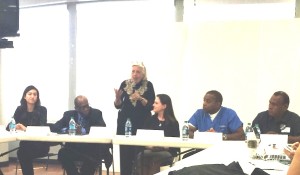Safety issues in California’s dialysis clinics put older Fil-Ams at risk

Panel discussion “How Safe are Dialysis Treatment Centers? Why Patients and Caregivers Urgently Seek Reform” hasted by New America Media. INQUIRER/ Hiyasmin Quijano
COMMERCE, California — Older Filipino Americans are among people put at risk if safety issues in dialysis clinics in the state are not addressed, warned supporters of a bill in the state legislature that seeks to put a spotlight on dialysis clinics.
With over 63,000 Californians including more than 25,000 Asian Americans who undergo dialysis, health care workers raised the urgency of ensuring safety in dialysis clinics during a panel discussion May 4 called “How Safe are Dialysis Treatment Centers? Why Patients and Caregivers Urgently Seek Reform” hosted by New America Media.
“An epidemiologic study among Asian Americans in Hawaii between 2001 and 2003 showed that Filipino Americans were at increased risk for developing chronic kidney disease if they were age 65 or older, or had hypertension or diabetes mellitus,” stated Stanford School of Medicine website page on ethnogeriatrics, which ranked kidney disease as one of the top ten leading causes of death among older adult Filipino Americans.
Senate Bill 349
Davita, a leading dialysis center, explains on its website: “Chronic kidney disease (CKD) is divided into five stages. The last stage is called end stage renal disease (ESRD) and is the time when dialysis or transplant is needed to stay alive.”
“Dialysis is a life-saving treatment for people with kidney failure. It’s time-consuming and dangerous because a patient’s blood is drained, filtered to remove toxins and then put back,” according to dialysis information given by SEIU-UHW.
Speakers stressed the need for California Senate Bill 349 to ensure dialysis clinic safety, by establishing minimum staffing requirements for dialysis clinics and a minimum transition time between patients receiving dialysis services at a treatment station.
Staffing issue
Dr. Randall Maxey, past president of the National Medical Association emphasized the need of a “patient before paycheck” culture for dialysis clinics, more employees who are culturally sensitive, and a need for a ‘patient-centric system.’”
Fil-Am dialysis registered nurse Daisy Dizon Reyes, stated, “During dialysis, we try to attend to them, especially those who cannot speak fluently [in English]. Language ability [such as knowing Tagalog] helps.”
“Sometimes a patient who is undergoing dialysis could experience low blood pressure or blood sugar and even pass out, so somebody needs to be right there to attend,” explained Fil-Am dialysis technician Vicki Santos on the dangers of working in understaffed conditions.

WATCH: Joan Allen of SEIU-UHW reports that the number of dialysis patients are increasing. INQUIRER/Hiyasmin Quijano
Megallan Handford, registered nurse and dialysis worker, said, “The unwritten policy is four is to one,” However, Handford explained that he has experienced being given six or more patients when an employee calls off work and the position is not filled.
Set up to fail
“We’re rushing to do work with policies and procedures that set us up to fail,” stated Handford on being understaffed and under time constraints for procedures.
Fil-Am advocates like Santos agree that safety is at risk with the current 15-minute transition time between patients.
In addition, Santos stated that infection control protocol could be implemented better and the transition time between patients increased to 45 minutes if SB 349 passes.
“It won’t solve everything [SB 349], but it’s a step forward on getting the dialysis [treatments] better,” concluded Fil-Am Issac Lubag, a relative of a dialysis patient.
“Dialysis is not terrible if you are doing it right,” said Dr. Maxey while explaining the need for more funding and extra staff. “The more nurses the better,” he added.
Non-union industry
Advocates are also concerned that dialysis treatment centers are a non-union industry, which Joan Allen of SEIU-UHW stressed.

WATCH: FilAm Dialysis Technician Vicki Santos hopes for safer transition time between patients through SB 349. INQUIRER/Hiyasmin Quijano
SEIU-UHW organizing director Cass Gualvez pointed out that the transition time given to an employee between patients is often not enough to implement dialysis procedures in the safest way.
“I’m scared, in the future when I sit on that chair, I will be going through the same scary and unprotected industry,” stated Lubag, a relative of a dialysis clinic employee who recently received news that he will eventually need dialysis treatment.
Dr. Maxey said “the real target is the U.S. Congress,” noting that there is no dialysis advocate on the “MedPac” Medicare Payment Advisory Commission that influences the pay rate.
He also noted that “half of the people who go on dialysis, don’t have to go on dialysis with a bit of preventive care.”

